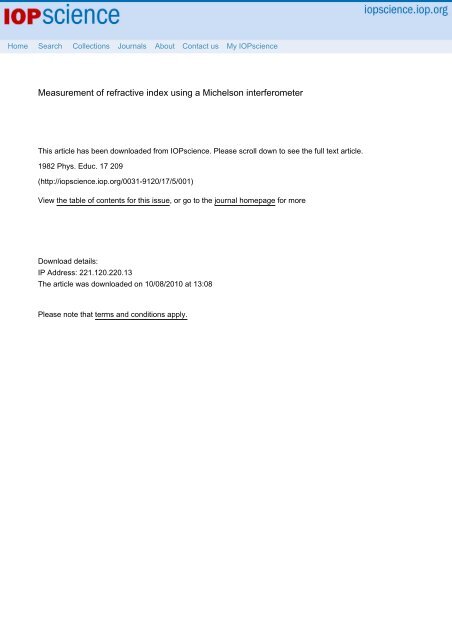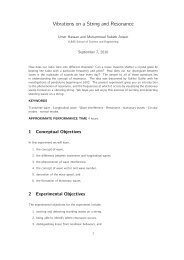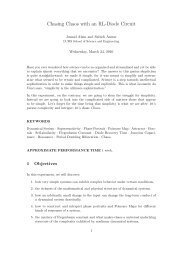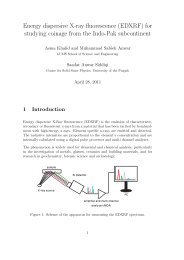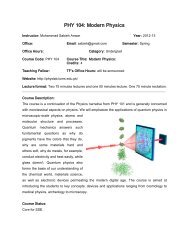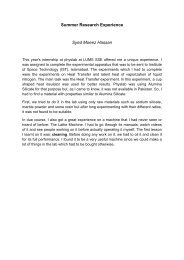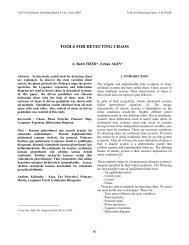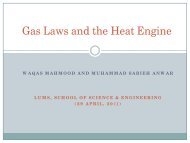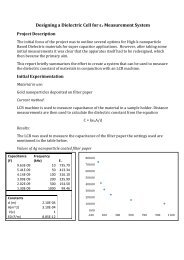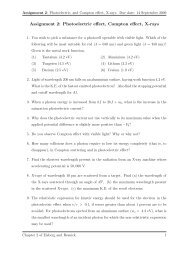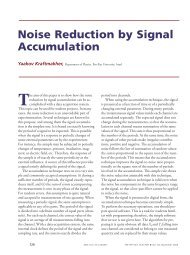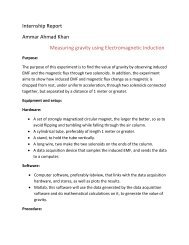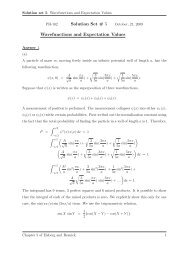Measurement of refractive index using a Michelson interferometer
Measurement of refractive index using a Michelson interferometer
Measurement of refractive index using a Michelson interferometer
Create successful ePaper yourself
Turn your PDF publications into a flip-book with our unique Google optimized e-Paper software.
Home Search Collections Journals About Contact us My IOPscience<strong>Measurement</strong> <strong>of</strong> <strong>refractive</strong> <strong>index</strong> <strong>using</strong> a <strong>Michelson</strong> <strong>interferometer</strong>This article has been downloaded from IOPscience. Please scroll down to see the full text article.1982 Phys. Educ. 17 209(http://iopscience.iop.org/0031-9120/17/5/001)View the table <strong>of</strong> contents for this issue, or go to the journal homepage for moreDownload details:IP Address: 221.120.220.13The article was downloaded on 10/08/2010 at 13:08Please note that terms and conditions apply.
"p<strong>Measurement</strong> <strong>of</strong><strong>refractive</strong> <strong>index</strong><strong>using</strong> a <strong>Michelson</strong>in terferome-ferJ J FendleyMonochromatlcTMlrror2PlateMirrorThe <strong>Michelson</strong> <strong>interferometer</strong> has long been apopular piece <strong>of</strong> equipment in the physics undergraduatelaboratory. One possible application is themeasurement <strong>of</strong> the <strong>refractive</strong> <strong>index</strong> <strong>of</strong> a thinparallel-side plate <strong>of</strong> transparent material <strong>of</strong> knownthickness. (Alternatively, if the <strong>refractive</strong> <strong>index</strong> isknown, the thickness <strong>of</strong> the plate may be determined.)This is accomplished by <strong>using</strong> 'white light' fringessuperimposed on monochromatic fringes and isdescribed in standard laboratory manuals (Whittleand Yarwood 1973). In this article another methodfor measuring the <strong>refractive</strong> <strong>index</strong> is described.Monochromatic fringes are used and plates rangingin thickness from a few micrometres to severalmillimetres may be measured.Consider the plate in one arm <strong>of</strong> the <strong>Michelson</strong><strong>interferometer</strong>. Let the ray which is normal to themirror M make an angle <strong>of</strong> incidence 'pi with the plate(figure 1). The change in phase <strong>of</strong> the ray as it passesthrough the plate may be determined from consideringfigure 2. The phase change <strong>of</strong> the ray in goingfrom P to Q is2nn2nnd-1. i. coscp,where i is the wavelength <strong>of</strong> the monochromatic light.n is the <strong>refractive</strong> <strong>index</strong>, d is the thickness. cp, is theangle <strong>of</strong> refraction and sin cpi = n sin cp,.vEyeFigure 1 Transparent plate. at angle W, to the beam, in onearm <strong>of</strong> the <strong>Michelson</strong> <strong>interferometer</strong>The equivalent ray in the other arm <strong>of</strong> the <strong>interferometer</strong>will pass through a corresponding airthickness and suffer a phase changeThus the phase difference between the two raysintroduced by the plate isi 12nnd 2nd cos(cpi - cp,)A=2 7-1. cos cp* i cos cp,The factor 2 is required because the ray passesthrough the plate twice.When the plate is normal to the ray (cpj = cpr = O),Figure 2 Details <strong>of</strong> the light path through the plateJack Fendley has heen an associate pr<strong>of</strong>essor in thecollege <strong>of</strong> engineering, King Ahdul Aziz C'niwrsit!*,Jedduh, Suudi Arabia since 1977. A,fter obtaining hisBSc and PI1 D ut Exeter Unirwsit)., he worked us areseardl <strong>of</strong>ficer ,for ERA Technolog). Ltd and thenlectured in the pll.vsics depurtnwnt <strong>of</strong> Chelsea College,London C'niwsit),. His previous researdl IWSconcerned nit11 the electrical properties <strong>of</strong> semiconductorsand riielrctric,.~ hut he is (,urrentlJ. )!,orkingon solar energ)', partic,ulurl), pltotovoltuic cells and theoptic,ul properties <strong>of</strong> surfaces.0031 91 2C 82 050203+33S2 00 I 1982 The nstl!.!te c' PP\j is 209
the phase difference between the two rays introducedby the plate isAo=2(F-Y)In turning the plate from the normal positionthrough the angle cpi, the change in the phasedifference between the two rays is (A - Ao). If thiscorresponds to m fringes, then (A - Ao) = 2nm andif n is known, d can be found from equation (1)immediately. If d is known and n unknown, it is notpossible to rearrange equation (1) to give a solutionfor n since cp, which itself depends on n, is unknown.However, n can be found by <strong>using</strong> a computer andstepping n untilI / \ I/Spindle/Pln', /G lassslldeis a minimum.An approximate value <strong>of</strong> n may be foundimmediately for small values <strong>of</strong> qi for which sincp Xcp, cos cp z (1 - cp2:'2) and cpi = ncp,. Equation (1)then becomesThis gives a startingcomputer program.n= cp:cpi - mi./d(2)value for n to be used in theExperimental procedureThe experimental arrangement is shown in figure 3.The plate was a standard glass slide <strong>of</strong> dimensions76 mm x 25 mm x 1 mm. A holder for the plate,which allowed the plate to be rotated, was made froman inexpensive protractor. A spindle cemented to theprotractor was located in a hole drilled into the base<strong>of</strong> the <strong>interferometer</strong>.It is important that the plate be made initiallynormal to the beam. A check with a set-squareshowed that the plate was perpendicular to the base<strong>of</strong> the <strong>interferometer</strong> to within *is. Using equation(2) and the values <strong>of</strong> n, i. and d given in the nextsection, this gives an error in m <strong>of</strong> k0.04 which isnegligible. To ensure that the plate was initially set atcpi = 0, the plate was rotated in its holder 3' to 4' <strong>of</strong>fnormal. As the plate was moved back towards thenormal position. the fringes moved one way, stoppedand then moved in the reverse direction. By notingthe position <strong>of</strong> the protractor for three fringes eitherside <strong>of</strong> the normal, the cpi = 0 position could be foundand a reference mark made on the base <strong>of</strong> the <strong>interferometer</strong>at the zero <strong>of</strong> the protractor.With a plate thickness <strong>of</strong> 1 mm there was a shift <strong>of</strong>approximately half a fringe/degree <strong>of</strong> rotation atUFigure 3 Holder for rotating the glass slidenormal incidence rising to approximately 15 fringes1degree at cp = 30'. By attaching an arm to theprotractor, some 2Ocm long, it was possible to rotatethe slide slowly enough to count the fringes at thehigher angles <strong>of</strong> incidence.The <strong>interferometer</strong> was set up for circular fringes.When the glass slide was placed in one arm at thenormal position, the fringes remain circular. Atheoretical analysis shows that the fringes becomeslightly elliptical as the slide is rotated, but with thepresent arrangement the effect was too small to benoticed with the unaided eye.ResultsA mercury discharge lamp with a green filter was usedas the light source to give monochromatic light <strong>of</strong>wavelength 546.2 nm. The thickness <strong>of</strong> the glass slidewas measured <strong>using</strong> a dial gauge and had a value <strong>of</strong>d = 1.025 i 0.002 mm. The angles cpi from the normalthrough which the slide was rotated for various fringeshifts m are given in table 1. The values <strong>of</strong> the<strong>refractive</strong> <strong>index</strong> n calculated from each pair <strong>of</strong>variables <strong>using</strong> a computer program are also given.The average value <strong>of</strong> the <strong>refractive</strong> <strong>index</strong> was n =1.481 +0.008. This should be compared with a value<strong>of</strong> 1.482 +0.004 found from the 'apparent depthmethod' (Nelkon and Parker 1970).Table 1 shows that the estimated precision in m andcpi was ki fringe and respectively. The relativeerror in m and cpi-and hence in n-will be large forsmall values <strong>of</strong> m and cpi and a minimum value <strong>of</strong> m= 20 corresponding to cpi = 10.4' was chosen as the210
starting point. In calculating the average value <strong>of</strong> ngiven in table 1. no attempt was made to weight theindividual values <strong>of</strong> n since such a detailed erroranalysis would be inconsistent with the unknownaccuracy <strong>of</strong> the protractor.DiscussionThe values <strong>of</strong> n given in table 1 appear to show asystematic increase with increasing v,. Possiblereasons for this include an error in setting the normalposition <strong>of</strong> the plate and/or a systematic error in theangular graduations <strong>of</strong> the protractor. The systematicchange in n is comparable with the random error andthe precision <strong>of</strong> the experiment must be improvedbefore it can be decided if the effect is real or not. Theprecision could be increased by <strong>using</strong> a properlymachined holder with an angular vernier scale. Sucha holder shouldbe provided with a screw arrange-ment to allow the slide to be turned slowly. With sucha device, readings <strong>of</strong> cp, to within +S minutes <strong>of</strong> arccould be obtained.In deriving equation (l), the multiple reflectionswithin the plate have not been considered. Ananalysis <strong>of</strong> this effect, assuming a noncomplex value<strong>of</strong> n (a perfect dielectric) shows that m is increased by(p - Po)/n where p is the additional phase change atangle <strong>of</strong> incidence cp, and p,, that at normal incidence,andtanb =r2 sin26l-r2 cos 26rn2 sin26,and tanPo =I-r,’ cos26,with 6 = 2nndcosrp,/i, 6, = 2nnd!i, ro= (n - l)/(n + 1) and r is the reflection coefficient at the anglerp, and is dependent on the polarisation <strong>of</strong> the light.For light polarised parallel and perpendicular to theplane <strong>of</strong> incidence.r =n coscp, - coscp,n coscp, + coscp,and -coscp, - n cosrp,rl - cos@; ,. + n cos@.For a full discussion <strong>of</strong> the reflection <strong>of</strong> light, seeKlein (1970). For the present experimental conditionsthe maximum value <strong>of</strong> I(B - po)/nI


